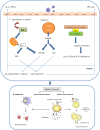Immune Responses to Influenza Virus and Its Correlation to Age and Inherited Factors
- PMID: 27920759
- PMCID: PMC5118461
- DOI: 10.3389/fmicb.2016.01841
Immune Responses to Influenza Virus and Its Correlation to Age and Inherited Factors
Abstract
Influenza viruses belong to the family Orthomyxoviridae of enveloped viruses and are an important cause of respiratory infections worldwide. The influenza virus is able to infect a wide variety species as diverse as poultry, marine, pigs, horses, and humans. Upon infection with influenza virus the innate immunity plays a critical role in efficient and rapid control of viral infections as well as in adaptive immunity initiation. The humoral immune system produces antibodies against different influenza antigens, of which the HA-specific antibody is the most important for neutralization of the virus and thus prevention of illness. Cell mediated immunity including CD4+ helper T cells and CD8+ cytotoxic T cells are the other arms of adaptive immunity induced upon influenza virus infection. The complex inherited factors and age related changes are associated with the host immune responses. Here, we review the different components of immune responses against influenza virus. Additionally, the correlation of the immune response to age and inherited factors has been discussed. These determinations lead to a better understanding of the limitations of immune responses for developing improved vaccines to control influenza virus infection.
Keywords: T cells; age associated factors; antibodies; immune responses; influenza virus; inherited factors.
Figures
Similar articles
-
Immune responses to influenza virus infection.Virus Res. 2011 Dec;162(1-2):19-30. doi: 10.1016/j.virusres.2011.09.022. Epub 2011 Sep 22. Virus Res. 2011. PMID: 21963677 Review.
-
Complement C3 Plays a Key Role in Inducing Humoral and Cellular Immune Responses to Influenza Virus Strain-Specific Hemagglutinin-Based or Cross-Protective M2 Extracellular Domain-Based Vaccination.J Virol. 2018 Sep 26;92(20):e00969-18. doi: 10.1128/JVI.00969-18. Print 2018 Oct 15. J Virol. 2018. PMID: 30068650 Free PMC article.
-
Generation of DelNS1 Influenza Viruses: a Strategy for Optimizing Live Attenuated Influenza Vaccines.mBio. 2019 Sep 17;10(5):e02180-19. doi: 10.1128/mBio.02180-19. mBio. 2019. PMID: 31530680 Free PMC article.
-
Activation of the RIG-I pathway during influenza vaccination enhances the germinal center reaction, promotes T follicular helper cell induction, and provides a dose-sparing effect and protective immunity.J Virol. 2014 Dec;88(24):13990-4001. doi: 10.1128/JVI.02273-14. Epub 2014 Sep 24. J Virol. 2014. PMID: 25253340 Free PMC article.
-
The immune system of chicken and its response to H9N2 avian influenza virus.Vet Q. 2023 Dec;43(1):1-14. doi: 10.1080/01652176.2023.2228360. Vet Q. 2023. PMID: 37357919 Free PMC article. Review.
Cited by
-
Identification of an Increased Alveolar Macrophage Subpopulation in Old Mice That Displays Unique Inflammatory Characteristics and Is Permissive to Mycobacterium tuberculosis Infection.J Immunol. 2019 Oct 15;203(8):2252-2264. doi: 10.4049/jimmunol.1900495. Epub 2019 Sep 11. J Immunol. 2019. PMID: 31511357 Free PMC article.
-
Antiviral Activity Exerted by Natural Products against Human Viruses.Viruses. 2021 May 4;13(5):828. doi: 10.3390/v13050828. Viruses. 2021. PMID: 34064347 Free PMC article. Review.
-
Can bacterial lysates be useful in prevention of viral respiratory infections in childhood? The results of experimental OM-85 studies.Front Pediatr. 2022 Nov 21;10:1051079. doi: 10.3389/fped.2022.1051079. eCollection 2022. Front Pediatr. 2022. PMID: 36479289 Free PMC article. Review.
-
A Replication-Defective Influenza Virus Vaccine Confers Complete Protection against H7N9 Viral Infection in Mice.Vaccines (Basel). 2020 May 2;8(2):207. doi: 10.3390/vaccines8020207. Vaccines (Basel). 2020. PMID: 32370136 Free PMC article.
-
Influenza A Virus (H1N1) Infection Induces Microglial Activation and Temporal Dysbalance in Glutamatergic Synaptic Transmission.mBio. 2021 Oct 26;12(5):e0177621. doi: 10.1128/mBio.01776-21. Epub 2021 Oct 26. mBio. 2021. PMID: 34700379 Free PMC article.
References
Publication types
LinkOut - more resources
Full Text Sources
Other Literature Sources
Research Materials



